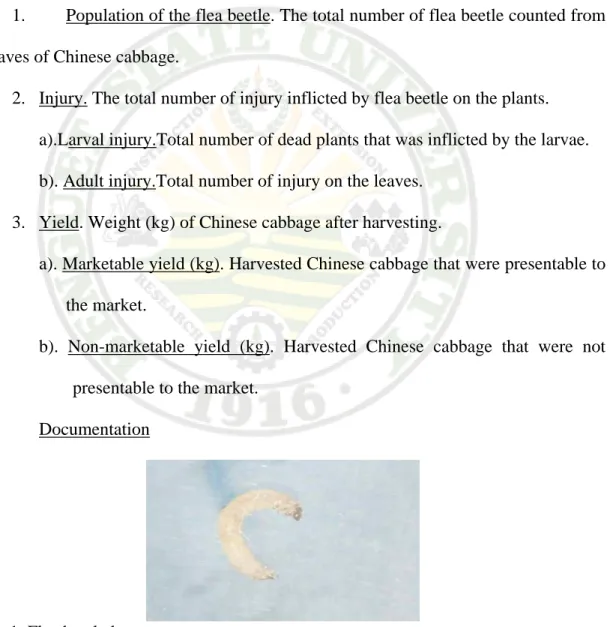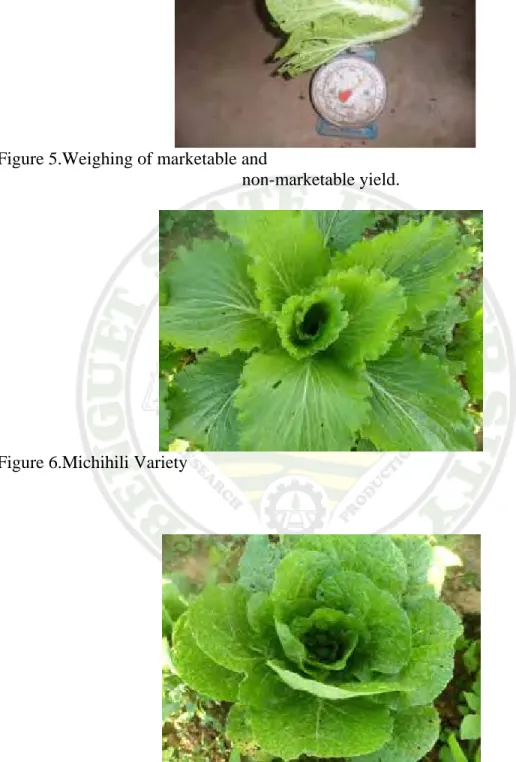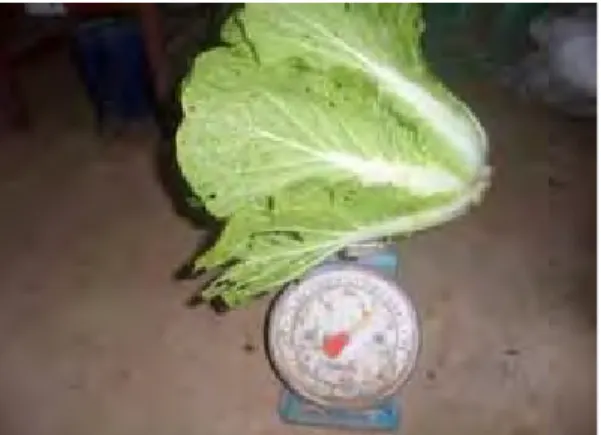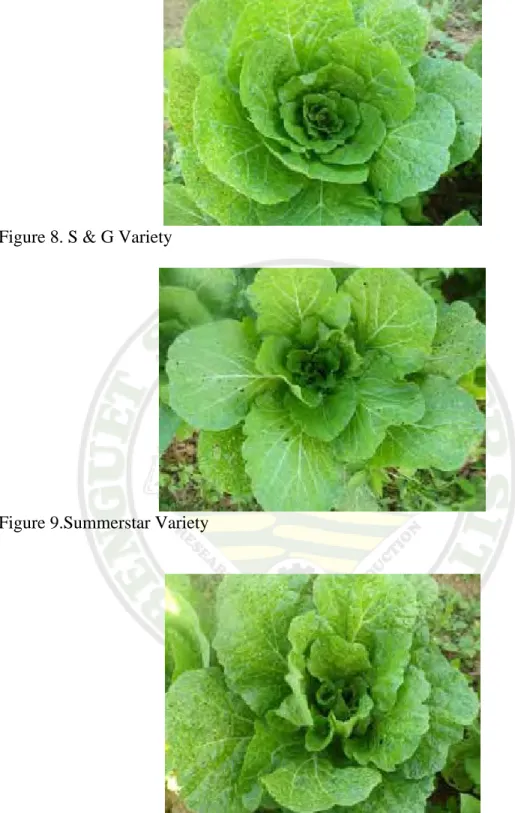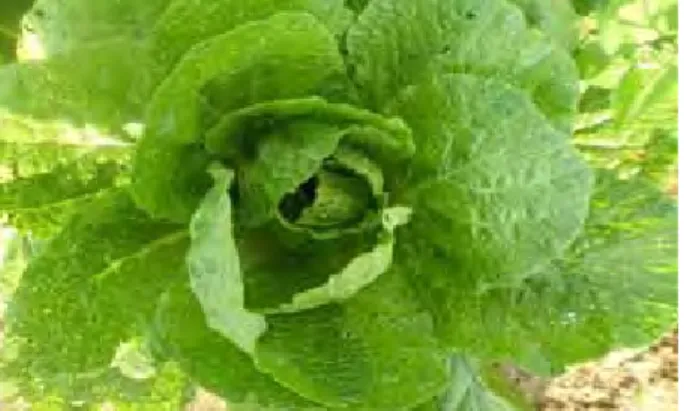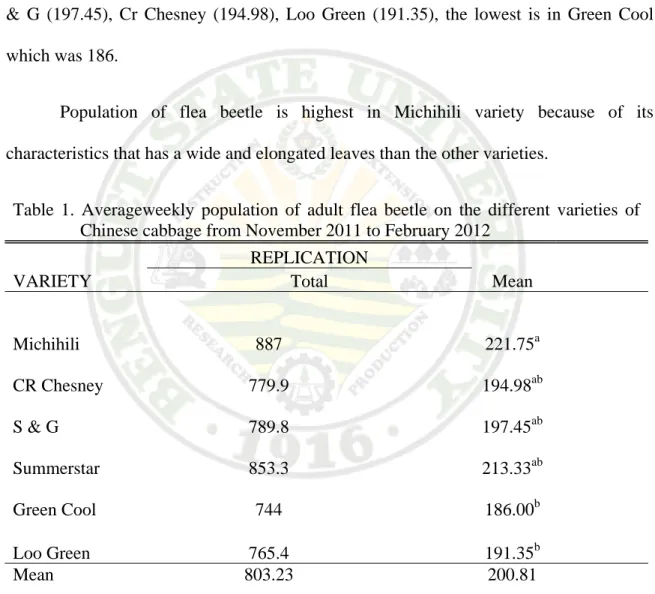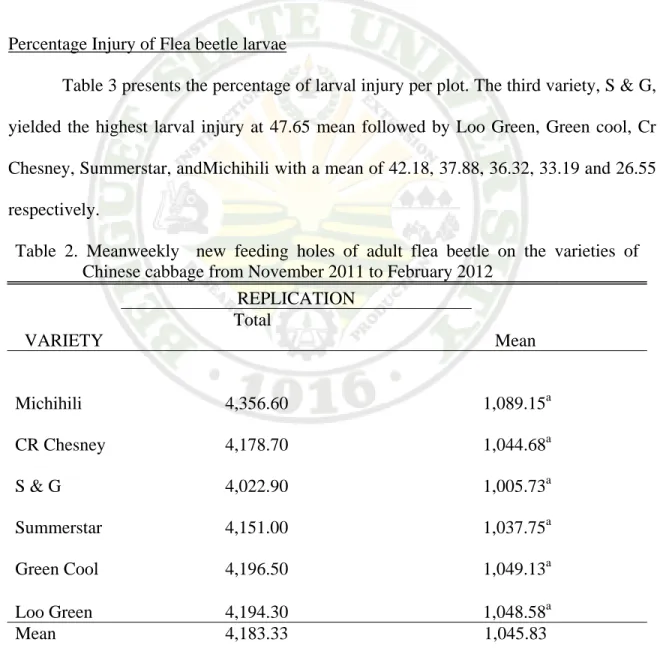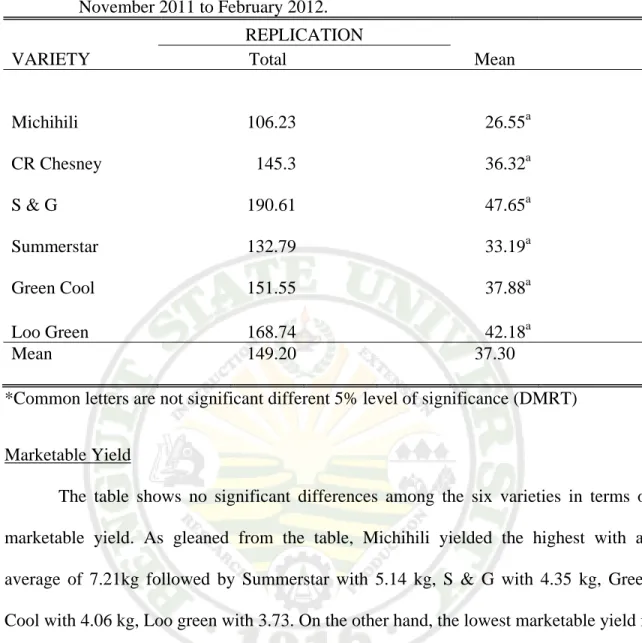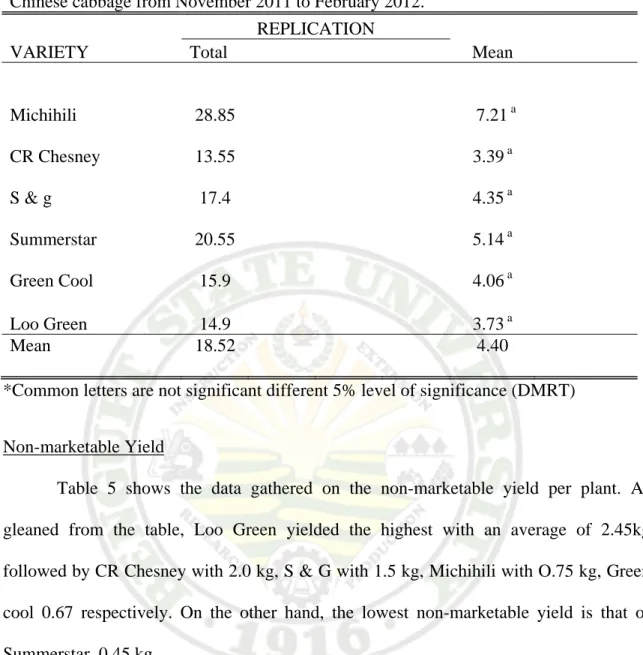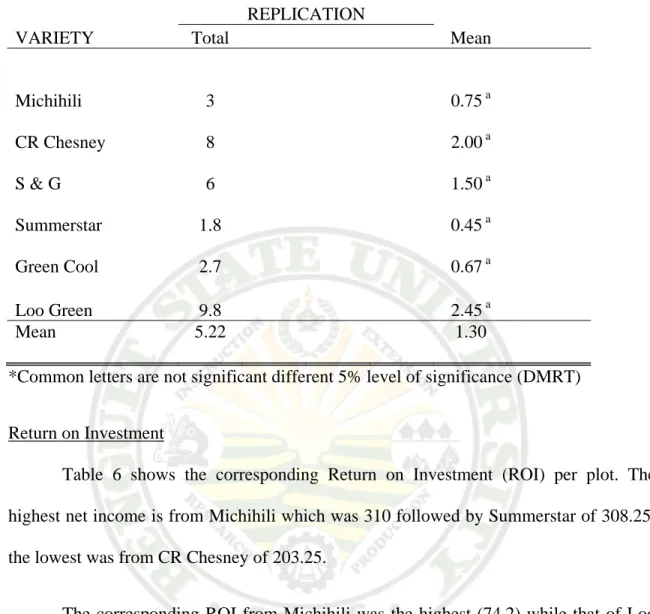Varietal Resistance of Chinese Cabbage (Brassica pekinensisHort) to Flea Beetle (PhyllotretaStriolataPokorney)/ Tiñas, Rey A. April 2012
TIÑAS, REY A. APRIL 2012. Varietal Resistance of Chinese Cabbage (Brassica pekinensisHort)to Flea Beetle (PhyllotretaStriolataPokorney). Benguet State University, La Trinidad, Benguet.
Adviser: Bonie S. Ligat, Msc., ABSTRACT
The study was conducted at Benguet State University Experimental Area in Balili, La Trinidad, Benguet from November 2011 to February 2012 to determined the population of flea beetle on the Chinese cabbage; to record the injury inflicted by the flea beetle on the Chinese cabbage; to determine the yield of Chinese cabbage and to compute the Return On Invesment (ROI) of each variety of Chinese cabbage.
Variety Michihili had the highest population of flea beetle adult; high on varieties Cr Chesney, S & G, Summerstar and low population of adult flea beetle on varieties Green Cool and Loo Green.
The injury of adult flea beetle had similar new feeding holes on the leaves of all varieties of Chinese cabbage used. There were less plants per hill that was injured by the larval flea beetle in the variety Michihili of 26.55%. The S & G variety had the highest number of plant per hill injured by the flea beetle larvae of 47.65%.
Michihili variety had the highest marketable & less non-marketable heads of Chinese cabbage.
Variety Michihili had the highest Return on Investment (ROI) of 74.2%.
Page
Bibliography ... i
Abstract……… i
Table of Contents... ii
INTRODUCTION………... 1
REVIEW OF LITERATURE... 3
MATERIALS AND METHODOLOGY……… 6
RESULTS AND DISCUSSION Weekly population of adult flea beetleon the different varieties of Chinese cabbage from November 2011 to February 12……… 13
Weekly new feeding holes ofadult flea beetle on the different varieties of Chinese cabbage from November 2011 to February 2012 ………….………. 14
Larval injury on the different Chinese cabbage from November 2011 to February 2012 ……….. 15
Marketable yield as inflicted by the flea beetle on the different varieties of Chinese cabbage from November 2011 to February 2012 (kg) ……….. 16
Non-marketable yield as inflicted by the flea beetle on the different varieties of Chinese cabbage from 2011 to February 2012 (kg)………... 17
Computed of return on investment (ROI) on the differentvarieties of Chinese cabbage fromNovember 2011 to February 2012………... 18
SUMMARY, CONCLUSION AND RECOMMENDATION …….………... 19
LITERATURE CITED... 21
APPENDICES... 22
Varietal Resistance of Chinese Cabbage (Brassica pekinensisHort) to Flea Beetle (PhyllotretaStriolataPokorney)/ Tiñas, Rey A. April 2012
INTRODUCTION
Chinese cabbage (Brassica pekinensisHort), one of the most major crops grown in the Philippines is most adapted to Benguet and around Cordillera region and most common leafy vegetables sold in our local markets. It is also known as one of the oldest vegetables in Asia. The different varieties of Chinese cabbage contains high vitamins and minerals, in fact some vegetables have higher vitamin C than the best source of fruits.
This vegetable contains most food nutrients. They are particular rich in minerals and vitamins.
Flea beetle is the common name to an insect of the family chrysomilidaeand the order of the coleopteran. Flea beetles are one of the most difficult to manage pest of cruciferous crops. There are various genera and species of flea beetles, all members of the chrysomilidae family. They occasionally damage vegetables, flowers, and even trees.
Adult’s flea beetle, which produce most plant injuries are typically small often shiny, and have larger rear legs that allow them to jump like a flea when disturbed. And also produce characteristics injury known as ‘shot holing”. The adults chew many small holes or pits in the leaves, which make them look as if they have been damage by fine buckshot. Young plants and seedlings are particularly susceptible. Growth may be retarded and even kill. Leaf feeding also of plant appearance. Further damage may be done by the larvae, which feed on the roots. Some flea beetles are considered general feeders, though many species attack only one plant or closely related kinds of plants (Metcalf and Metcalf, 1995).
The findings of the study will guide and provide important information to all vegetable grower in which of the varieties of Chinese cabbage will be having good yield and more immuned to a flea beetle. Furthermore it will help the vegetables grower to lesser their farm input.
The studies aimed were to determine the population of flea beetle on the chinese cabbage leaves, to monitor the injury inflicted by the flea beetle on the leaf of Chinese cabbage and to determine the yield of the chinese cabbage.
The studies were conducted at Benguet State University Experimental Area in Balili, La Trinidad, Benguet from November 2011 to February 2012.
Varietal Resistance of Chinese Cabbage (Brassica pekinensisHort) to Flea Beetle (PhyllotretaStriolataPokorney)/ Tiñas, Rey A. April 2012
REVIEW OF LITERATURE
Varietal Evaluation
Bautista and Mabesa (1997), selecting the right variety will minimize problems associated with water and fertilizer management. The variety to be selected should be less input and ensure profit.
The findings of Bionde (1995), from his study on varietal resistance showed that turnips, mustards and Chinese cabbage were more resistant vegetables to insect pest.
Cadiz (1990) found that most variety of Chinese cabbage imported from Hongkong, Taiwan, and Japan appear adapted to the Philippine conditions. They are adapted elevations in the cool and dry season.
Ecology and Description of Flea beetle
Adult flea beetle feed externally on plants, eating the surface of the leaves, stems and petals. Under heavy feeding the small round holes caused by an individual flea beetles feedings may coalesce into larger areas of damage. Some flea beetles are root feeders. In adverse weather conditions some flea beetles seek shelter in the soil. Some species, such as phyllotretacruciferae and striolata, prefer to leave their hide out only during jumping ability and this behavior of hiding in the soil (Whiting and Wilson, 2002).
Flea beetle is found in a wide variety of habits, forest as well as fields and prairies. In Hungary it is common of the leaf beetle assemblages in basswood and maple canopies, but only as visiting or “tourist” species (Vig and Mark, 2005).
Most of the present information on the biology flea beetle was compiled from European literature since the species has been little investigated in North America. In the
Europe, flea beetles over winters as adults which emerged at the end of March and the beginning of April when the temperature is 8-9 degrees Celsius. They search for appropriate host plants, and the feeding flea beetle is characterized by numerous small holes bordered by a narrow line of dead brown leaf (Jourdevil, 1993).
Levesque (2009) considered several flea beetle species as companion specie of grape pest into vineyards of the Eastern townships in Quebes, Canada since this flea beetle thriving on various weeds within the vineyards, but not on grape itself. It was the third most common leaf beetle species of the L” Orpailleur vineyard and the fourth at Dietrich- joss among the 59 species of the leaf beetle fauna in raspberry fields at John Ville in Southern Quebec where it was replaced by the native flea beetle.
Life Cycle of Flea Beetle
Flea beetles over winter as adults under soil and leaf litter in brushy or woody areas surrounding fields, rather than in grassy areas right next to fields. They emerge in early spring when temperatures reach about 50 degrees, feeding on weeds or crops, if available. Females soon lay their eggs in the soil at the base of these plants. Eggs hatch in a week or two and the larvae feed on plants until fully grown. Then they pupate in the soil for 11 to 13 days before emerging as adults. Delaying the planting dates of susceptible crops until after the over wintering beetles have emerged is one way to reduce damage to young plants (Whiting and Wilson, 2002).
Varietal Characteristics
Variety choice in organic farming is an essential factor of successful production.
But there is significant lack of information on the performance of varieties under organic
Varietal Resistance of Chinese Cabbage (Brassica pekinensisHort) to Flea Beetle (PhyllotretaStriolataPokorney)/ Tiñas, Rey A. April 2012
conditions. As conventional plant breeding aims at optimizing yields under high input conditions. As diversity of organic farming system and condition is large and results in a larger genotype-environment-management interaction than in conventional Agriculture, the organic farmers is more interested in varieties, that have the ability to adapt to variable conditions and performed well with stable yields in different years at the specific site. In many countries there are variety trials under organic conditions but not for every crop and every year. Some are conducted by farmers groups, others research station or by chemical seed companies. In the organic sector, the non-chemical approach also has effects on traits concerning product quality such as long term storability without sprouting inhibitors for cabbage and potatoes (Lammerts Van Buerenet al., 2004).
MATERIALS AND METHODOLOGY
Materials
The materials used were digital camera, gasoline, tractors, grab hoe, compost, watering can, sunflower leaves, papers, gypsum, foliar, record book and seeds of Chinese cabbage.
Land Preparation
The provide 24 plots area was cleaned by the used of grab hoe, then after cleaning the cleaned area were cultivated by the used of hand tractor. The plots measured 1m x 10m each. Chinese cabbage seeds were planted in double rows at a distance of 25cm x25cm rows. The Chinese cabbage seed that planted were bought from the La Trinidad, Benguet Farm Supply. Prior to planting, the soil was fertilized with compost and gypsum lime. The plants were irrigated manually every other day. Application of fermented sunflower leaves and foliar fertilizer as spray was done one week after plant emergence to help for the growth of the plant.
Fertilization
The gathered sunflower leaves from Benguet State University garden was chop with the used of bolo and was put on the drum and add with water until it was full and covered with plastic for fermentation to 4-5 days. The fermented leaves was mixed with water (10 ml/L of water) and watered on the plants with the use of watering can.
Varietal Resistance of Chinese Cabbage (Brassica pekinensisHort) to Flea Beetle (PhyllotretaStriolataPokorney)/ Tiñas, Rey A. April 2012
Monotoring the Population of Flea beetle to Chinese Cabbage
In monitoring the population of flea beetle to chinese cabbage were taken weekly.
There were ten plants that was taken per treatment at random as samples. The flea beetle were counted visually on the plant leaves and were recorded. Fleabeetle that just jump into the leaves during the counting were not included.
Monitoring the New Feeding Holes of Flea beetle to Chinese Cabbage
The new feeding holes inflicted to chinese cabbage were taken weekly. There were ten plants that was taken per treatment at random as samples. Needing holes was counted visually on the outside leaves of the chinese cabbage. New feeding holes are typically small often shiny. The counted feeding holes were recorded.
Yield
Yield was gathered on the ten plants of chinese cabbage that was taken per treatment at random as samples. The chinese cabbage were harvested and were classified to marketable and non marketable. In marketable yield, the chinese cabbage were cut and removed the inflicted leaves and it was weighed (kg). After it was weighed and packed it was brought to the market. The chinese cabbage thatwas not bought and was returned were added into the non-marketable yield.
The six treatments laid in a Randomized Complete Block Design (RCBD) replicated four times.
The varieties were:
T1-Michihili (Ramgo seeds)
T2-Chinese cabbage F1 Hybrid Cr Chesney T3-S & G (Syngenta seeds)
T4-Summers star T5-Green cool
T6–Loo Greens (Hybrid Syngenta seeds) Data Gathered were:
1. Population of the flea beetle. The total number of flea beetle counted from the leaves of Chinese cabbage.
2. Injury. The total number of injury inflicted by flea beetle on the plants.
a).Larval injury.Total number of dead plants that was inflicted by the larvae.
b). Adult injury.Total number of injury on the leaves.
3. Yield. Weight (kg) of Chinese cabbage after harvesting.
a). Marketable yield (kg). Harvested Chinese cabbage that were presentable to the market.
b). Non-marketable yield (kg). Harvested Chinese cabbage that were not presentable to the market.
Documentation
Figure 1. Flea beetle larva
F
fl
Va
igure 2. Adu
lea beetle lar
rietal Resistan
ult Flea beetl
rvae
Figu
ce of Chinese C (Phyllot
le
Figure 3. C
ure 4.New fe
Cabbage (Bras tretaStriolataP
Chinese cabb
eeding holes
sica pekinensis Pokorney)/ Tiña
age inflicted
of adult flea
sHort) to Flea B as, Rey A. April
d of
a beetle.
Beetle l 2012
Figure 5.Weighing of marketable and
non-marketable yield.
Figure 6.Michihili Variety
Figure 7. Cr Chesney Variety
Varietal Resistance of Chinese Cabbage (Brassica pekinensisHort) to Flea Beetle (PhyllotretaStriolataPokorney)/ Tiñas, Rey A. April 2012
Figure 8. S & G Variety
Figure 9.Summerstar Variety
Figure 10 Loo Green Variety
Figure 11. Green Cool Variety
Varietal Resistance of Chinese Cabbage (Brassica pekinensisHort) to Flea Beetle (PhyllotretaStriolataPokorney)/ Tiñas, Rey A. April 2012
RESULTS AND DISCUSSION
Adult Flea Beetle Population
As shown in Table 1, the total population of Michihili variety significantly differs from that of Green Cool and Loo Green, the mean weekly population per plant was highest in the Michihili variety with a mean (221.75) followed by Summerstar(213.33), S
& G (197.45), Cr Chesney (194.98), Loo Green (191.35), the lowest is in Green Cool which was 186.
Population of flea beetle is highest in Michihili variety because of its characteristics that has a wide and elongated leaves than the other varieties.
Table 1. Averageweekly population of adult flea beetle on the different varieties of Chinese cabbage from November 2011 to February 2012
VARIETY
REPLICATION
Mean Total
Michihili 887 221.75a
CR Chesney 779.9 194.98ab
S & G 789.8 197.45ab
Summerstar 853.3 213.33ab
Green Cool 744 186.00b
Loo Green 765.4 191.35b
Mean 803.23 200.81
*Common letters are notsignificant different 5% level of significance (DMRT)
Percentage Injury of Adult Flea beetle
Table 2 shows that there is no significant different on the new feeding holes of flea beetle in each plant and in each variety. Among the six varieties, Michihili had the highest mean feeding holes (1089.15) followed by Green Cool (1049.13), Loo Green (1048.58), Cr Chesney (1044.68), Summerstar (1037.75), and the lowest is S & G with a total mean of 1005.73.
Michihili has a thin leaves were the flea beetle can easily consume on it.
Percentage Injury of Flea beetle larvae
Table 3 presents the percentage of larval injury per plot. The third variety, S & G, yielded the highest larval injury at 47.65 mean followed by Loo Green, Green cool, Cr Chesney, Summerstar, andMichihili with a mean of 42.18, 37.88, 36.32, 33.19 and 26.55 respectively.
Table 2. Meanweekly new feeding holes of adult flea beetle on the varieties of Chinese cabbage from November 2011 to February 2012
VARIETY
REPLICATION
Mean Total
Michihili 4,356.60 1,089.15a
CR Chesney 4,178.70 1,044.68a
S & G 4,022.90 1,005.73a
Summerstar 4,151.00 1,037.75a
Green Cool 4,196.50 1,049.13a
Loo Green 4,194.30 1,048.58a
Mean 4,183.33 1,045.83
*Common letters are not significant different 5% level of significance (DMRT)
Varietal Resistance of Chinese Cabbage (Brassica pekinensisHort) to Flea Beetle (PhyllotretaStriolataPokorney)/ Tiñas, Rey A. April 2012
Table 3. Percentage larval injury on the different varieties of Chinese cabbage from November 2011 to February 2012.
VARIETY
REPLICATION
Mean Total
Michihili 106.23 26.55a
CR Chesney 145.3 36.32a
S & G 190.61 47.65a
Summerstar 132.79 33.19a
Green Cool 151.55 37.88a
Loo Green 168.74 42.18a
Mean 149.20 37.30
*Common letters are not significant different 5% level of significance (DMRT) Marketable Yield
The table shows no significant differences among the six varieties in terms of marketable yield. As gleaned from the table, Michihili yielded the highest with an average of 7.21kg followed by Summerstar with 5.14 kg, S & G with 4.35 kg, Green Cool with 4.06 kg, Loo green with 3.73. On the other hand, the lowest marketable yield is that of Cr Chesney 3.39 kg.
Yield is highest onMichihili were it produce many leaves and has good appearance.
Table 4. Mean marketable yield as inflicted flea beetle on the different varieties of Chinese cabbage from November 2011 to February 2012.
VARIETY
REPLICATION
Mean
Total
Michihili 28.85 7.21 a
CR Chesney 13.55 3.39 a
S & g 17.4 4.35 a
Summerstar 20.55 5.14 a
Green Cool 15.9 4.06 a
Loo Green 14.9 3.73 a
Mean 18.52 4.40
*Common letters are not significant different 5% level of significance (DMRT) Non-marketable Yield
Table 5 shows the data gathered on the non-marketable yield per plant. As gleaned from the table, Loo Green yielded the highest with an average of 2.45kg followed by CR Chesney with 2.0 kg, S & G with 1.5 kg, Michihili with O.75 kg, Green cool 0.67 respectively. On the other hand, the lowest non-marketable yield is that of Summerstar, 0.45 kg.
Varietal Resistance of Chinese Cabbage (Brassica pekinensisHort) to Flea Beetle (PhyllotretaStriolataPokorney)/ Tiñas, Rey A. April 2012
Table 5. Meannon-marketable yield as inflicted of flea beetle on the different varieties of Chinese cabbage from November 2011 to February 2012.
VARIETY
REPLICATION
Mean Total
Michihili 3 0.75 a
CR Chesney 8 2.00a
S & G 6 1.50a
Summerstar 1.8 0.45a
Green Cool 2.7 0.67a
Loo Green 9.8 2.45a
Mean 5.22 1.30
*Common letters are not significant different 5% level of significance (DMRT) Return on Investment
Table 6 shows the corresponding Return on Investment (ROI) per plot. The highest net income is from Michihili which was 310 followed by Summerstar of 308.25;
the lowest was from CR Chesney of 203.25.
The corresponding ROI from Michihili was the highest (74.2) while that of Loo Green was the least (8.78). It is further observed that the one with highest ROI had the highest net income and the lowest expense.
Table 6. Average computed return on investment (ROI) on the different varieties of Chinese cabbage from November 2011 to February 2012.
VARIETY Return on investment
Michihili 74.20 a
CR Chesney 12.72a
S & G 24.02a
Summerstar 59.84a
Green Cool 26.46a
Loo Green 8.78a
Mean 34.37
*Common letters are not significant different 5% level of significance(DMRT)
Varietal Resistance of Chinese Cabbage (Brassica pekinensisHort) to Flea Beetle (PhyllotretaStriolataPokorney)/ Tiñas, Rey A. April 2012
SUMMARY, CONCLUSION AND RECOMMENDATION
Summary
The study was conducted at Benguet State University Experimental Area in Balili, La Trinidad, Benguet from November 2011 to February 2012 to determine varieties, which posses degree of resistance against flea beetle infestation, monitor the injury on the plant leaves and were correlate the population of flea beetle to the injury on leaves and yield of Chinese cabbage plant.
Among the six varieties of Chinese cabbage evaluated, the highest weekly feeding holes is Michihili with means of 1089.15 respectively respectively were resistant to flea beetle, conversely the other varieties Green Cool (1049.73), Loo Greens (1048.58), Cr Chesney (1044.68), Summerstar (1037.75), and Syngenta (1005.73).
The total marketable yield of Chinese cabbage were in the highest total for the variety of Michihili with a mean of 7.21, followed by the Summerstar (5.14), S & G (4.35), Green Cool (4.06), Loo Green (3.73) and Cr Chesney (3.39)
Conclusion
Therefore, Michihili variety has the highest population of flea beetle, highest in injury and highest in yield, were in the characteristics has wide elongated leaves and produce many leaves than the other variety.
Recommendation
Among the six varieties, Michihili are recommended to plant during months when beetle is high that it exhibited resistance to flea beetle. Furthermore, it was stated on the studies that it was the highest marketable yield and on return on investment. Although at
different growing season that all the varieties of Chinese cabbage could be planted by growers in the field but in terms of resistant plant, the MichihiliRamgo Seeds.
Varietal Resistance of Chinese Cabbage (Brassica pekinensisHort) to Flea Beetle (PhyllotretaStriolataPokorney)/ Tiñas, Rey A. April 2012
LITERATURE CITED
BAUTISTA, O. K. and R. G. MABESA. 1997. Vegetable Production. Los Baňos, Laguna, Colleges of Agriculture. P. 28.
BIONDE, M.S. 1995.Varietal resistance to insect attack in various cruciferous crops.Journal Econ. Entom. 59 (2): 130-135.
CADIZ, L. M. 1990. Varietal Evaluation. Year book of Agriculture: Philippine Agriculturist. P.8.
JOURDEVIL, L. S. 1993. Host Plants and Defense Mechanism. (3rd edition). New Delhi:
Oxford and IBA Publishing Co. Pp. 57-75.
LAMMERTS VAN BUEREN, E. T., H. J. M VAN SOEST. , E. C.DE GROOT, I. W.
BOOKEMA. And A. M. OSMAN 2004.Broadening the genetics base for better adapted varieties for organic farming systems. Characterization and assessment of cabbage accession for new basic population. Rodale Press, Emmaus, PA.534 p.
LEVESQUE,S. W. 2009. Check list to the flea beetle species occurring in Canada (Coleoptera) Fragmenta Entomological 22: 109- 183.
METCALF, R. L. and R. A. METCALF. 1995. Destructive and Useful Insects, (5th edition). New York McGraw- Hill Book Co., NY. Pp. 14-15.
VIG, E. G. and M. L. MARK. 2005. Flea beetles (Coleoptera) of Hungary habitat use and host plant associations. Proceedings of the Entomological Society of Washington 106: 858- 864.
WHITING, D. and C. WILSON. 2002.Flea beetle Ecology.Department of Entomology, Virginia Tech. Pp. 31- 32.
APPENDIX
Table 1. Weekly Adult Flea Beetle Total Population per Plant
TREATMENT
BLOCKS
Total Mean
I II III IV
Michihili 217.8 223.3 218.4 227.5 887 221.75 CR Chesney 205.6 195.4 191 187.9 779.9 194.975 S & G 202.4 198 198.6 190.8 789.8 197.45 Summerstar 226.4 220.6 214.1 192.2 853.3 213.325 Green Cool 168.8 193.5 197.9 183.8 744 186 Loo Green 187.2 197.9 204.7 175.6 765.4 191.35 TOTAL 1208.2 1228.7 1224.7 1157.8 4819.4 1204.85 MEAN 201.37 204.78 204.12 192.97 803.23 200.81
ANOVA TABLE SOURCE OF
VARIATION
SUM OF SQUARES
DEGREE OF FREEDOM
MEAN SQUARE
COMPUTED
F F0.05
BLOCKS 531.295 3 177.0983 1.849952 3.287382
TREATMENT 3797.093 5 759.4187 7.932812* 2.901295
Error 1435.97 15 95.73133
Total 5764.358 23
*significant
Varietal Resistance of Chinese Cabbage (Brassica pekinensisHort) to Flea Beetle (PhyllotretaStriolataPokorney)/ Tiñas, Rey A. April 2012
Table 2. Weekly New Feeding Holes of Flea Beetle per Plant
TREATMENT
BLOCKS
Total Mean
I II III IV
Michihili 1,050.20 1,114.80 1,074.50 1,117.10 4,356.60 1,089.15 CR Chesney 1,055.90 1,033.80 1,053.30 1,035.70 4,178.70 1,044.68 S & G 1,048.10 948.8 1,039.80 986.2 4,022.90 1,005.73 Summerstar 1,061.40 1,032.00 1,056.50 1,001.10 4,151.00 1,037.75 Green Cool 1,109.90 1,009.80 1,035.90 1,040.90 4,196.50 1,049.13 Loo Green 1,037.20 1,055.70 1,042.30 1,059.10 4,194.30 1,048.58 TOTAL 6,362.70 6,194.90 6,302.30 6,240.10 25,100.00 6,275.00 MEAN 1,060.45 1,032.48 1,050.38 1,040.02 4,183.33 1,045.83
ANOVA TABLE SOURCE OF
VARIATION
SUM OF SQUARES
DEGREE OF FREEDOM
MEAN SQUARE
COMPUTED
F F0.05 BLOCKS 2678.433 3 892.8111 0.860119 3.287382 TREATMENT 14280.18 5 2856.037 2.751456ns 2.901295
Error 15570.14 15 1038.009
Total 32528.75 23
nsnot significant
Table 3. Larval Injury per Plot (%)
TREATMENT
BLOCKS
Total Mean
I II III IV
Michihili 17.18 15.62 53.12 20.31 106.23 26.5575 CR Chesney 40.62 31.25 34.37 39.06 145.3 36.325 S & G 45.31 17.18 45.31 82.81 190.61 47.6525 Summerstar 53.12 29.68 28.12 21.87 132.79 33.1975 Green Cool 15.62 25 76.56 34.37 151.55 37.8875 Loo Green 39.06 75 17.18 37.5 168.74 42.185 TOTAL 210.91 193.73 254.66 235.92 895.22 223.805
MEAN 35.15 32.29 42.44 39.32 149.20 37.30
ANOVA TABLE SOURCE OF
VARIATION
SUM OF SQUARES
DEGREE OF FREEDOM
MEAN SQUARE
COMPUTED
F F0.05 BLOCKS 361.5985 3 120.5328 0.248054 3.287382 TREATMENT 1058.26 5 211.6521 0.435576ns 2.901295
Error 7288.694 15 485.9129
Total 8708.552 23
nsnot significant
Varietal Resistance of Chinese Cabbage (Brassica pekinensisHort) to Flea Beetle (PhyllotretaStriolataPokorney)/ Tiñas, Rey A. April 2012
Table 4. Marketable Yield per Plant (kg)
TREATMENT
BLOCKS
Total Mean
I II III IV
Michihili 8.25 4.2 6.2 10.2 28.85 7.2125
CR Chesney 2.5 5.4 3.9 1.75 13.55 3.3875
S & G 1.75 5.35 4.8 2.5 14.4 3.6
Summerstar 3.25 7.65 6.15 3.5 20.55 5.1375
Green Cool 2.5 2.7 3.8 4.28 13.28 3.32
Loo Green 4.65 3.9 1.75 4.6 14.9 3.725
TOTAL 22.9 29.2 26.6 26.83 105.53 26.3825
MEAN 3.82 4.87 4.43 4.47 17.59 4.40
ANOVA TABLE SOURCE OF
VARIATION
SUM OF SQUARES
DEGREE OF FREEDOM
MEAN SQUARE
COMPUTED
F F0.05 BLOCKS 3.385612 3 1.128537 0.307916 3.287382 TREATMENT 46.96477 5 9.392954 2.562819ns 2.901295
Error 54.97631 15 3.665088
Total 105.3267 23
nsnot significant
Table 5. Non-marketable Yield per Plant (kg)
TREATMENT
BLOCKS
Total Mean
I II III IV
Michihili 0 1 2 0 3 0.75
CR Chesney 1 0 0 7 8 2
S & G 2.5 0 1 2.5 6 1.5
Summerstar 0.5 0 0.5 0.8 1.8 0.45
Green Cool 1.25 0.5 0.7 0.25 2.7 0.675
Loo Green 8 0.8 0 1 9.8 2.45
TOTAL 13.25 2.3 4.2 11.55 31.3 7.825
MEAN 2.21 0.38 0.70 1.93 5.22 1.30
ANOVA TABLE SOURCE OF
VARIATION
SUM OF SQUARES
DEGREE OF FREEDOM
MEAN SQUARE
COMPUTED
F F0.05
BLOCKS 14.49542 3 4.831806 1.046493 3.28738 TREATMENT 13.07208 5 2.614417 0.566242ns 2.90129
Error 69.25708 15 4.617139
Total 96.82458 23
nsnot significant
Varietal Resistance of Chinese Cabbage (Brassica pekinensisHort) to Flea Beetle (PhyllotretaStriolataPokorney)/ Tiñas, Rey A. April 2012
Table 6.ROI on Michihili Variety per Plot. Total Expenses ÷ Treatment
EXPENSES QUANTITY UNIT PRICE TOTAL
Land preparation 1 ½ days 200 50
Planting 1 day 200 33.33
Watering 7 days 200 233.33
Spraying 2 days 200 66.66
Weeding 1 ½ days 200 50
Gypsum 1 sack 900 150
Foliar 1 liter 135 22.5
Gasoline 2 liters 48 16
Michihili 2 pack 45 90
Total= 711.78
*Total Expenses = 711.78 = 177.94 4 replication 4
ROI= Total Net Income – Total expenses Total Expenses
Given: 5.17 Price: 60 (5.17) ROI= 310- 177.94x 100 177.94 ROI = 74.21 %
Table 7.ROI on Cr Chesney Variety per Plot. Total Expenses ÷ Treatment
EXPENSES QUANTITY UNIT PRICE TOTAL
Land preparation 1 ½ days 200 50
Planting 1 day 200 33.33
Watering 7 days 200 233.33
Spraying 2 days 200 66.66
Weeding 1 ½ days 200 50
Gypsum 1 sack 900 150
Foliar 1 liter 135 22.5
Gasoline 2 liters 48 16
Cr Chesney 1 pack 100 100
Total= 721.78
*Total Expenses = 721.78 = 180.44 4 replication 4
ROI= Total Net Income – Total expenses Total Expenses
Given: 3.39 Price: 60 (3.39) ROI= 203.4 – 180.44x 100
180 .44
ROI = 12.72 %
Varietal Resistance of Chinese Cabbage (Brassica pekinensisHort) to Flea Beetle (PhyllotretaStriolataPokorney)/ Tiñas, Rey A. April 2012
Table 8.ROI on S & G Variety per Plot. Total Expenses ÷ Treatment
EXPENSES QUANTITY UNIT PRICE TOTAL
Land preparation 1 ½ days 200 50
Planting 1 day 200 33.33
Watering 7 days 200 233.33
Spraying 2 days 200 66.66
Weeding 1 ½ days 200 50
Gypsum 1 sack 900 150
Foliar 1 liter 135 22.5
Gasoline 2 liters 48 16
S & G 1 pack 220 220
Total= 841.78
*Total Expenses = 841.78 = 210.44 4 replication 4
ROI= Total Net Income – Total expenses Total Expenses
Given: 4.35 Price: 60 (4.35) ROI= 261-210.44 x 100
210.44 ROI = 24.02 %
Table 9.ROI on Summerstar Variety per Plot. Total Expenses ÷ Treatment
EXPENSES QUANTITY UNIT PRICE TOTAL
Land preparation 1 ½ days 200 50
Planting 1 day 200 33.33
Watering 7 days 200 233.33
Spraying 2 days 200 66.66
Weeding 1 ½ days 200 50
Gypsum 1 sack 900 150
Foliar 1 liter 135 22.5
Gasoline 2 liters 48 16
Summerstar 2 pack 75 150
Total= 771.78
*Total Expenses = 771.78= 192.94 4 replication 4
ROI= Total Net Income – Total expenses Total Expenses
Given: 5.14 Price: 60 (5.14) ROI= 308.4 – 192.94 x 100 192.94
ROI = 59.84 %
Varietal Resistance of Chinese Cabbage (Brassica pekinensisHort) to Flea Beetle (PhyllotretaStriolataPokorney)/ Tiñas, Rey A. April 2012
Table 10.ROI on Green Cool Variety per Plot. Total Expenses ÷ Treatment
EXPENSES QUANTITY UNIT PRICE TOTAL
Land preparation 1 ½ days 200 50
Planting 1 day 200 33.33
Watering 7 days 200 233.33
Spraying 2 days 200 66.66
Weeding 1 ½ days 200 50
Gypsum 1 sack 900 150
Foliar 1 liter 135 22.5
Gasoline 2 liters 48 16
Green Cool 2 pack 75 150
Total= 771.78
*Total Expenses = 771.78 = 192.94 4 replication 4
ROI= Total Net Income – Total expenses Total Expenses
Given: 4.06 Price: 60 (4.06) ROI= 244 – 192.94 x 100
192.94 ROI = 26.46 %
Table 11.ROI on Loo Green Variety per Plot. Total Expenses ÷ Treatment
EXPENSES QUANTITY UNIT PRICE TOTAL
Land preparation 1 ½ days 200 50
Planting 1 day 200 33.33
Watering 7 days 200 233.33
Spraying 2 days 200 66.66
Weeding 1 ½ days 200 50
Gypsum 1 sack 900 150
Foliar 1 liter 135 22.5
Gasoline 2 liters 48 16
Loo Green 1 pack 200 200
Total= 821.78
*Total Expenses = 821.78 = 205.45 4 replication 4
ROI= Total Net Income – Total expenses Total Expenses
Given: 3.73 Price: 60 (3.73) ROI= 223.5 – 205.45 x 100
205.45 ROI = 8.78 %
